Analysis of Beef Consumption in Australia: Research Proposal
VerifiedAdded on 2020/03/16
|23
|4284
|70
Report
AI Summary
This research proposal examines the strategies to increase beef consumption in Australia. It begins with an abstract summarizing the decreasing demand for beef and the role of Meat & Livestock Australia (MLA) in researching and assisting farming companies. The introduction provides background on the importance of meat consumption in Australia, the decline in beef consumption, and MLA's mission. The problem definition identifies the core issue as declining beef demand. Research objectives include identifying customer preferences, factors affecting consumption, ways to increase cattle production, methods to reduce negative factors, and gaps in the market. The literature review explores various articles related to beef and milk production, environmental and economic impacts of technologies, and consumer preferences. The research methods section outlines the research philosophy, approach, design, and methods, along with data collection and analysis. Ethical considerations and limitations are also discussed. The report also includes a proposed time schedule and an approximate budget. The study seeks to identify factors influencing consumer behavior and strategies for beef production to increase consumption in Australia.
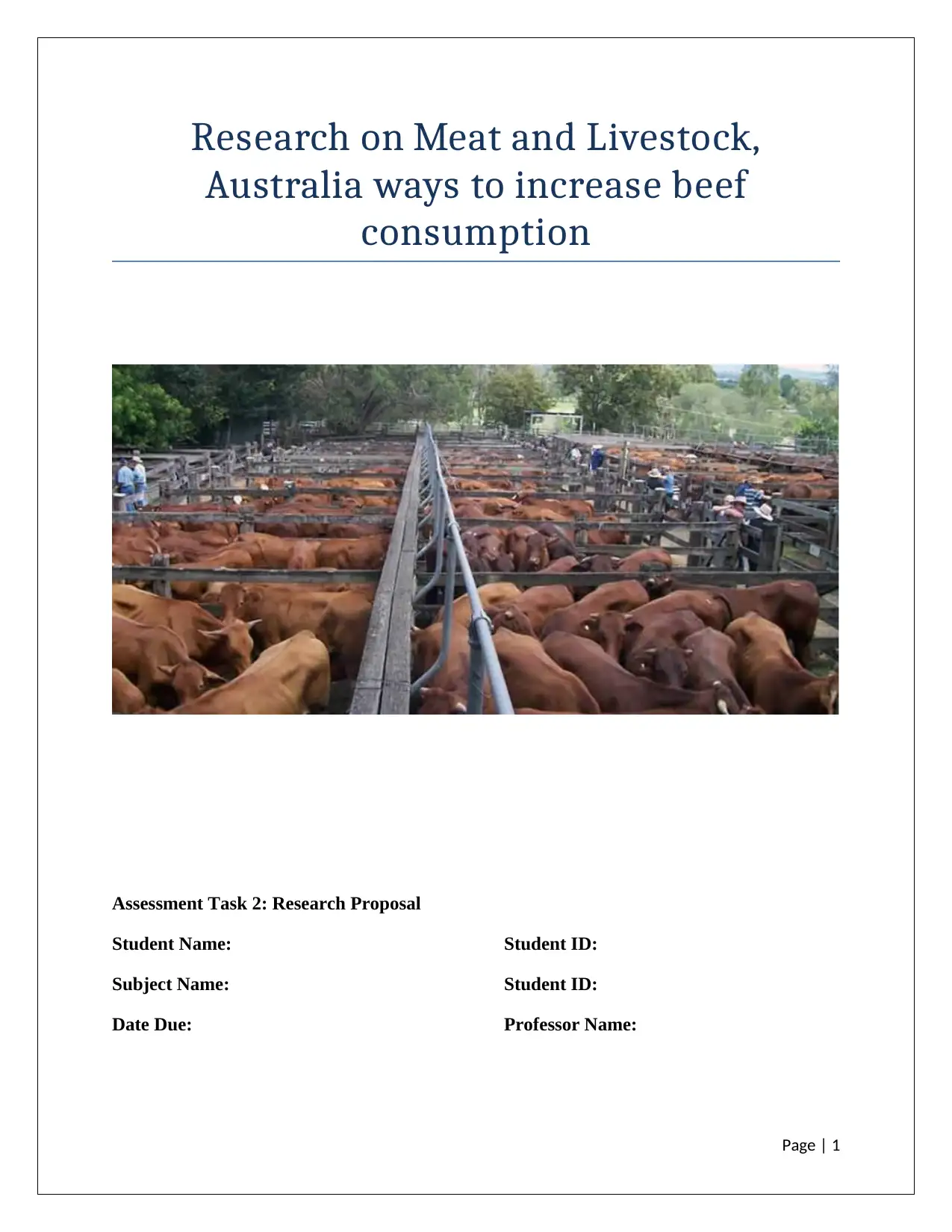
Research on Meat and Livestock,
Australia ways to increase beef
consumption
Assessment Task 2: Research Proposal
Student Name: Student ID:
Subject Name: Student ID:
Date Due: Professor Name:
Page | 1
Australia ways to increase beef
consumption
Assessment Task 2: Research Proposal
Student Name: Student ID:
Subject Name: Student ID:
Date Due: Professor Name:
Page | 1
Paraphrase This Document
Need a fresh take? Get an instant paraphrase of this document with our AI Paraphraser
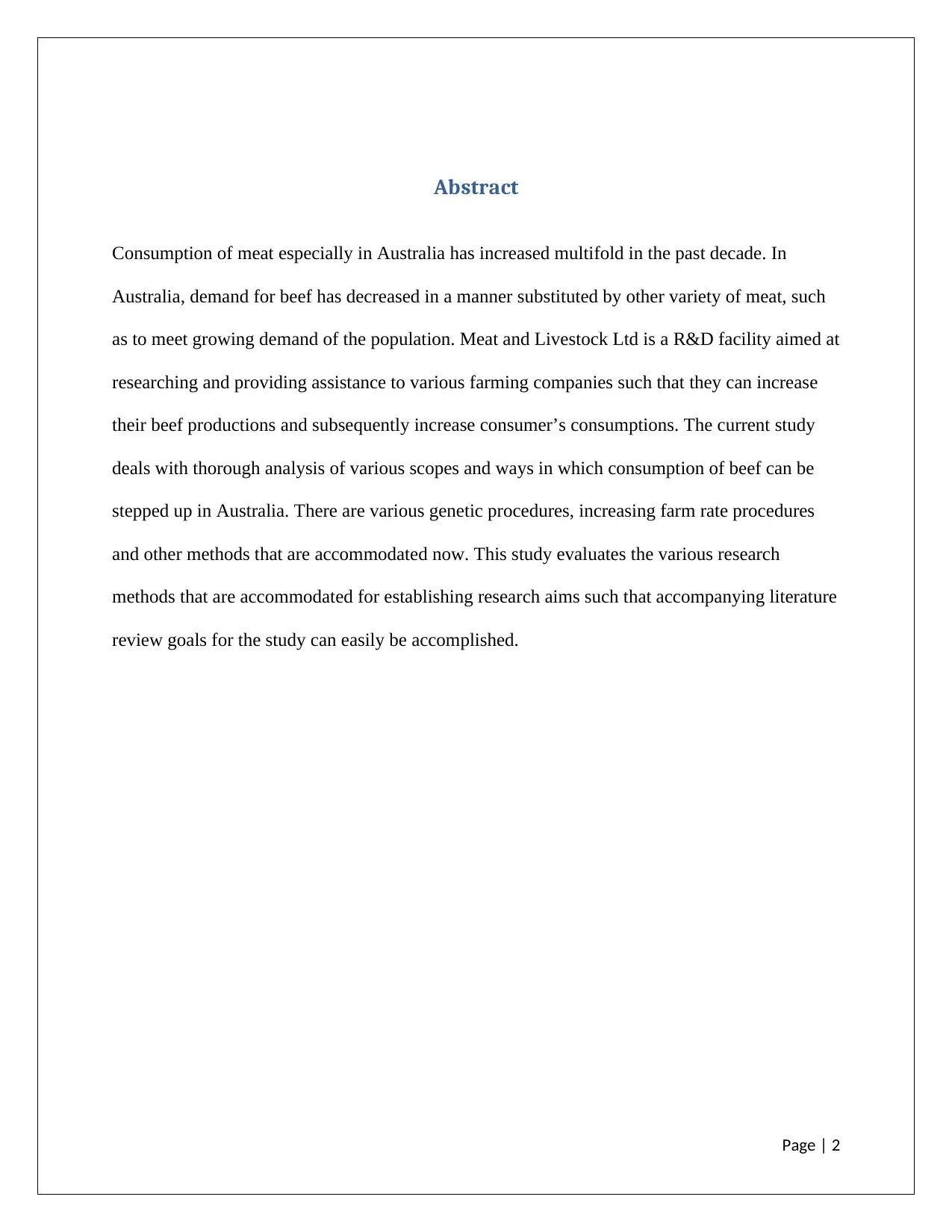
Abstract
Consumption of meat especially in Australia has increased multifold in the past decade. In
Australia, demand for beef has decreased in a manner substituted by other variety of meat, such
as to meet growing demand of the population. Meat and Livestock Ltd is a R&D facility aimed at
researching and providing assistance to various farming companies such that they can increase
their beef productions and subsequently increase consumer’s consumptions. The current study
deals with thorough analysis of various scopes and ways in which consumption of beef can be
stepped up in Australia. There are various genetic procedures, increasing farm rate procedures
and other methods that are accommodated now. This study evaluates the various research
methods that are accommodated for establishing research aims such that accompanying literature
review goals for the study can easily be accomplished.
Page | 2
Consumption of meat especially in Australia has increased multifold in the past decade. In
Australia, demand for beef has decreased in a manner substituted by other variety of meat, such
as to meet growing demand of the population. Meat and Livestock Ltd is a R&D facility aimed at
researching and providing assistance to various farming companies such that they can increase
their beef productions and subsequently increase consumer’s consumptions. The current study
deals with thorough analysis of various scopes and ways in which consumption of beef can be
stepped up in Australia. There are various genetic procedures, increasing farm rate procedures
and other methods that are accommodated now. This study evaluates the various research
methods that are accommodated for establishing research aims such that accompanying literature
review goals for the study can easily be accomplished.
Page | 2
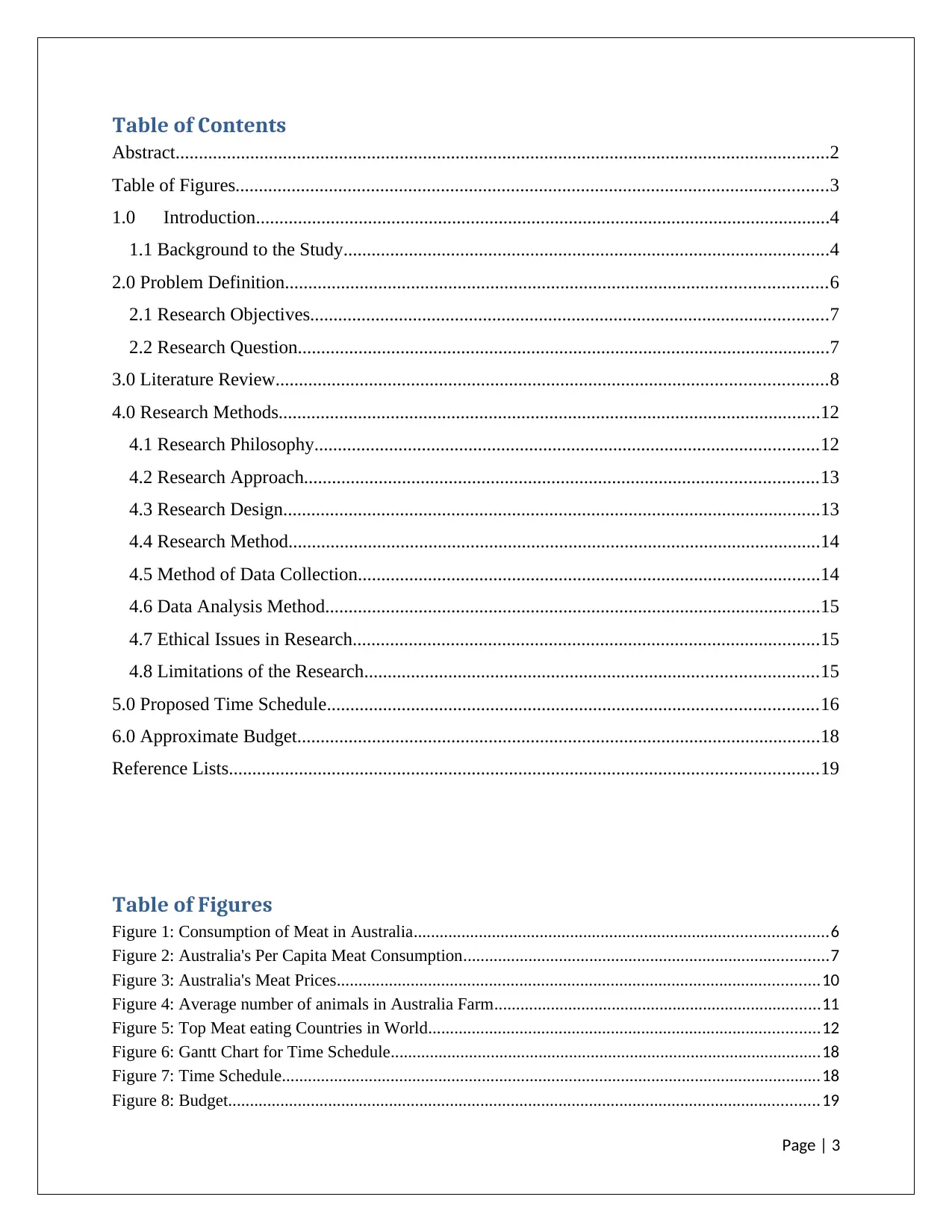
Table of Contents
Abstract............................................................................................................................................2
Table of Figures...............................................................................................................................3
1.0 Introduction...........................................................................................................................4
1.1 Background to the Study........................................................................................................4
2.0 Problem Definition....................................................................................................................6
2.1 Research Objectives...............................................................................................................7
2.2 Research Question..................................................................................................................7
3.0 Literature Review......................................................................................................................8
4.0 Research Methods....................................................................................................................12
4.1 Research Philosophy............................................................................................................12
4.2 Research Approach..............................................................................................................13
4.3 Research Design...................................................................................................................13
4.4 Research Method..................................................................................................................14
4.5 Method of Data Collection...................................................................................................14
4.6 Data Analysis Method..........................................................................................................15
4.7 Ethical Issues in Research....................................................................................................15
4.8 Limitations of the Research.................................................................................................15
5.0 Proposed Time Schedule.........................................................................................................16
6.0 Approximate Budget................................................................................................................18
Reference Lists..............................................................................................................................19
Table of Figures
Figure 1: Consumption of Meat in Australia...............................................................................................6
Figure 2: Australia's Per Capita Meat Consumption....................................................................................7
Figure 3: Australia's Meat Prices...............................................................................................................10
Figure 4: Average number of animals in Australia Farm...........................................................................11
Figure 5: Top Meat eating Countries in World..........................................................................................12
Figure 6: Gantt Chart for Time Schedule...................................................................................................18
Figure 7: Time Schedule............................................................................................................................18
Figure 8: Budget........................................................................................................................................19
Page | 3
Abstract............................................................................................................................................2
Table of Figures...............................................................................................................................3
1.0 Introduction...........................................................................................................................4
1.1 Background to the Study........................................................................................................4
2.0 Problem Definition....................................................................................................................6
2.1 Research Objectives...............................................................................................................7
2.2 Research Question..................................................................................................................7
3.0 Literature Review......................................................................................................................8
4.0 Research Methods....................................................................................................................12
4.1 Research Philosophy............................................................................................................12
4.2 Research Approach..............................................................................................................13
4.3 Research Design...................................................................................................................13
4.4 Research Method..................................................................................................................14
4.5 Method of Data Collection...................................................................................................14
4.6 Data Analysis Method..........................................................................................................15
4.7 Ethical Issues in Research....................................................................................................15
4.8 Limitations of the Research.................................................................................................15
5.0 Proposed Time Schedule.........................................................................................................16
6.0 Approximate Budget................................................................................................................18
Reference Lists..............................................................................................................................19
Table of Figures
Figure 1: Consumption of Meat in Australia...............................................................................................6
Figure 2: Australia's Per Capita Meat Consumption....................................................................................7
Figure 3: Australia's Meat Prices...............................................................................................................10
Figure 4: Average number of animals in Australia Farm...........................................................................11
Figure 5: Top Meat eating Countries in World..........................................................................................12
Figure 6: Gantt Chart for Time Schedule...................................................................................................18
Figure 7: Time Schedule............................................................................................................................18
Figure 8: Budget........................................................................................................................................19
Page | 3
⊘ This is a preview!⊘
Do you want full access?
Subscribe today to unlock all pages.

Trusted by 1+ million students worldwide
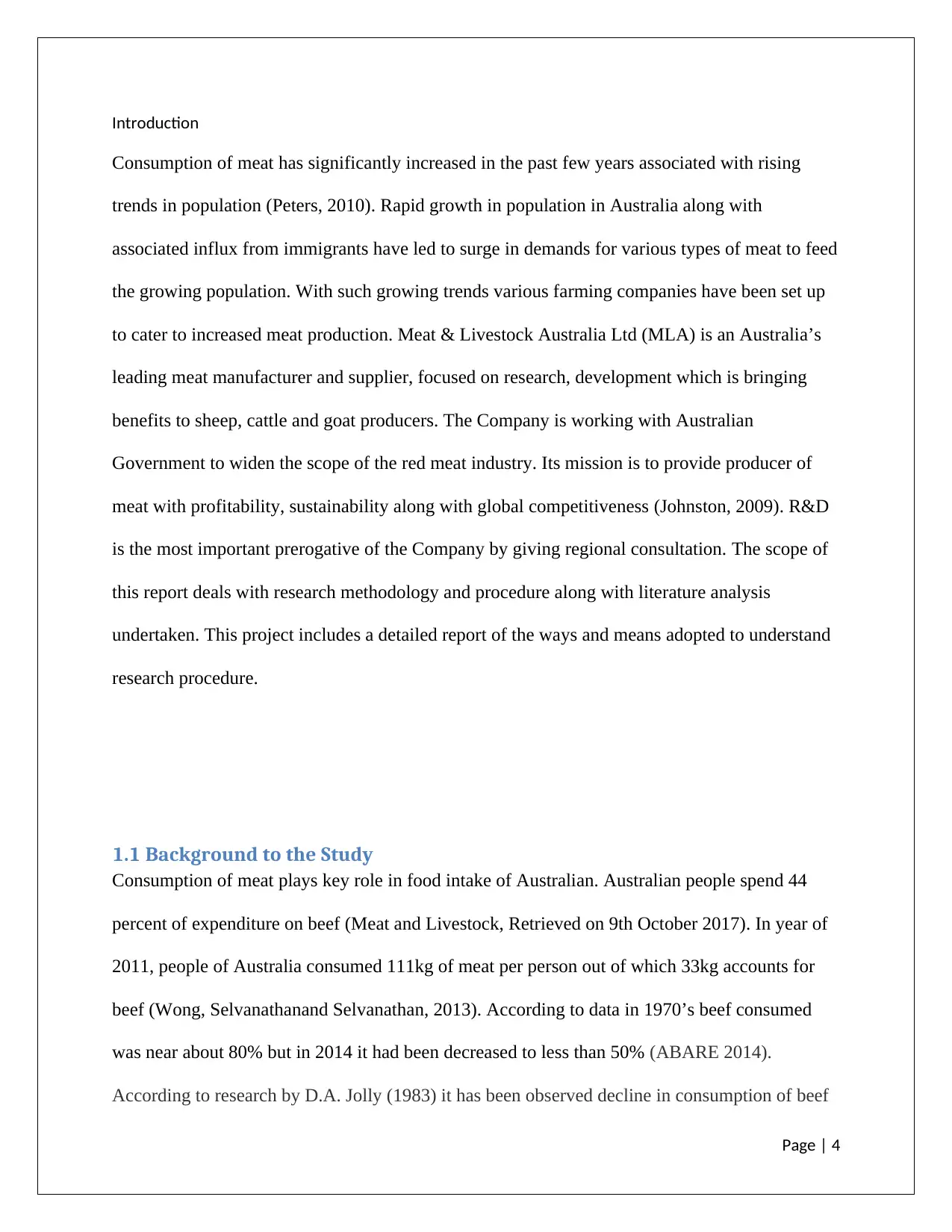
Introduction
Consumption of meat has significantly increased in the past few years associated with rising
trends in population (Peters, 2010). Rapid growth in population in Australia along with
associated influx from immigrants have led to surge in demands for various types of meat to feed
the growing population. With such growing trends various farming companies have been set up
to cater to increased meat production. Meat & Livestock Australia Ltd (MLA) is an Australia’s
leading meat manufacturer and supplier, focused on research, development which is bringing
benefits to sheep, cattle and goat producers. The Company is working with Australian
Government to widen the scope of the red meat industry. Its mission is to provide producer of
meat with profitability, sustainability along with global competitiveness (Johnston, 2009). R&D
is the most important prerogative of the Company by giving regional consultation. The scope of
this report deals with research methodology and procedure along with literature analysis
undertaken. This project includes a detailed report of the ways and means adopted to understand
research procedure.
1.1 Background to the Study
Consumption of meat plays key role in food intake of Australian. Australian people spend 44
percent of expenditure on beef (Meat and Livestock, Retrieved on 9th October 2017). In year of
2011, people of Australia consumed 111kg of meat per person out of which 33kg accounts for
beef (Wong, Selvanathanand Selvanathan, 2013). According to data in 1970’s beef consumed
was near about 80% but in 2014 it had been decreased to less than 50% (ABARE 2014).
According to research by D.A. Jolly (1983) it has been observed decline in consumption of beef
Page | 4
Consumption of meat has significantly increased in the past few years associated with rising
trends in population (Peters, 2010). Rapid growth in population in Australia along with
associated influx from immigrants have led to surge in demands for various types of meat to feed
the growing population. With such growing trends various farming companies have been set up
to cater to increased meat production. Meat & Livestock Australia Ltd (MLA) is an Australia’s
leading meat manufacturer and supplier, focused on research, development which is bringing
benefits to sheep, cattle and goat producers. The Company is working with Australian
Government to widen the scope of the red meat industry. Its mission is to provide producer of
meat with profitability, sustainability along with global competitiveness (Johnston, 2009). R&D
is the most important prerogative of the Company by giving regional consultation. The scope of
this report deals with research methodology and procedure along with literature analysis
undertaken. This project includes a detailed report of the ways and means adopted to understand
research procedure.
1.1 Background to the Study
Consumption of meat plays key role in food intake of Australian. Australian people spend 44
percent of expenditure on beef (Meat and Livestock, Retrieved on 9th October 2017). In year of
2011, people of Australia consumed 111kg of meat per person out of which 33kg accounts for
beef (Wong, Selvanathanand Selvanathan, 2013). According to data in 1970’s beef consumed
was near about 80% but in 2014 it had been decreased to less than 50% (ABARE 2014).
According to research by D.A. Jolly (1983) it has been observed decline in consumption of beef
Page | 4
Paraphrase This Document
Need a fresh take? Get an instant paraphrase of this document with our AI Paraphraser
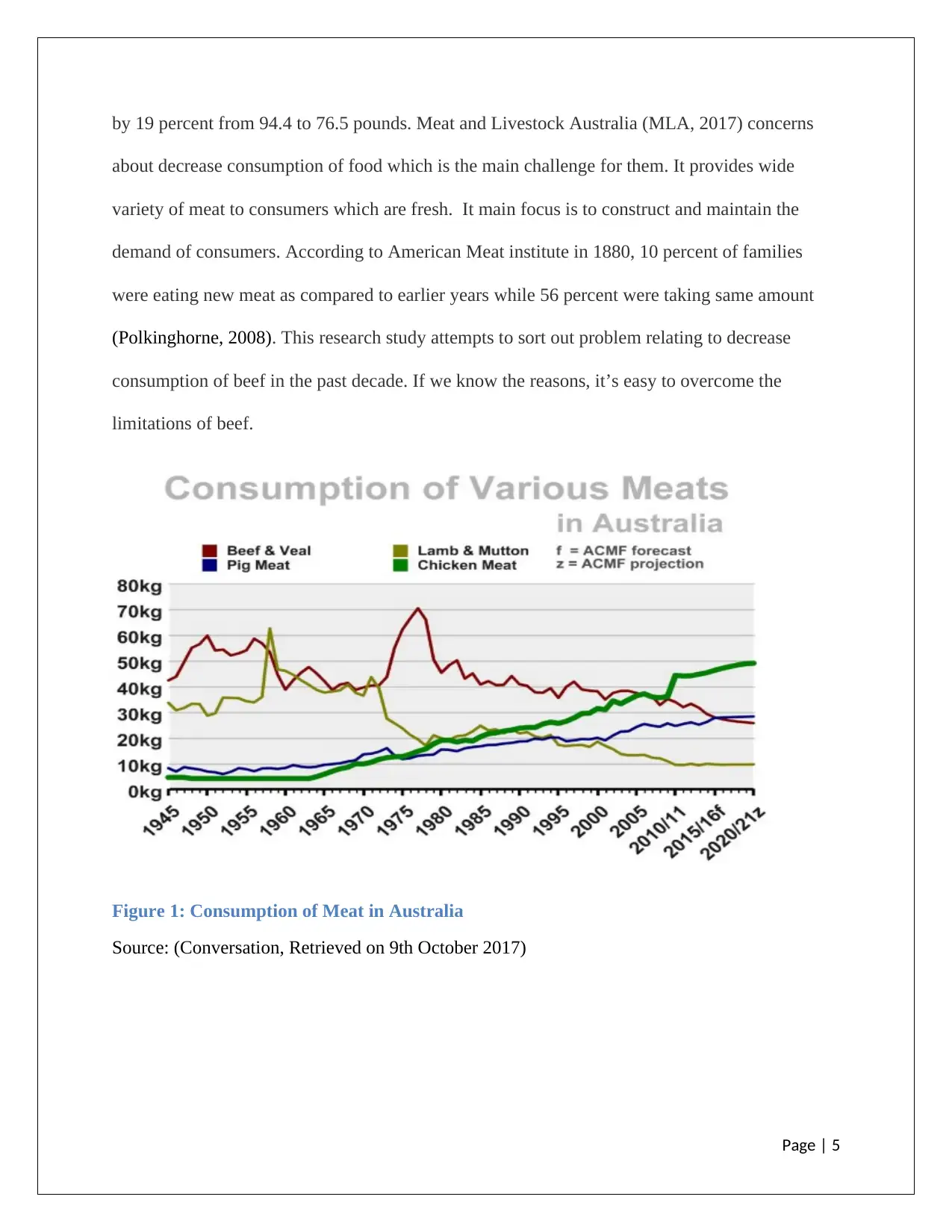
by 19 percent from 94.4 to 76.5 pounds. Meat and Livestock Australia (MLA, 2017) concerns
about decrease consumption of food which is the main challenge for them. It provides wide
variety of meat to consumers which are fresh. It main focus is to construct and maintain the
demand of consumers. According to American Meat institute in 1880, 10 percent of families
were eating new meat as compared to earlier years while 56 percent were taking same amount
(Polkinghorne, 2008). This research study attempts to sort out problem relating to decrease
consumption of beef in the past decade. If we know the reasons, it’s easy to overcome the
limitations of beef.
Figure 1: Consumption of Meat in Australia
Source: (Conversation, Retrieved on 9th October 2017)
Page | 5
about decrease consumption of food which is the main challenge for them. It provides wide
variety of meat to consumers which are fresh. It main focus is to construct and maintain the
demand of consumers. According to American Meat institute in 1880, 10 percent of families
were eating new meat as compared to earlier years while 56 percent were taking same amount
(Polkinghorne, 2008). This research study attempts to sort out problem relating to decrease
consumption of beef in the past decade. If we know the reasons, it’s easy to overcome the
limitations of beef.
Figure 1: Consumption of Meat in Australia
Source: (Conversation, Retrieved on 9th October 2017)
Page | 5
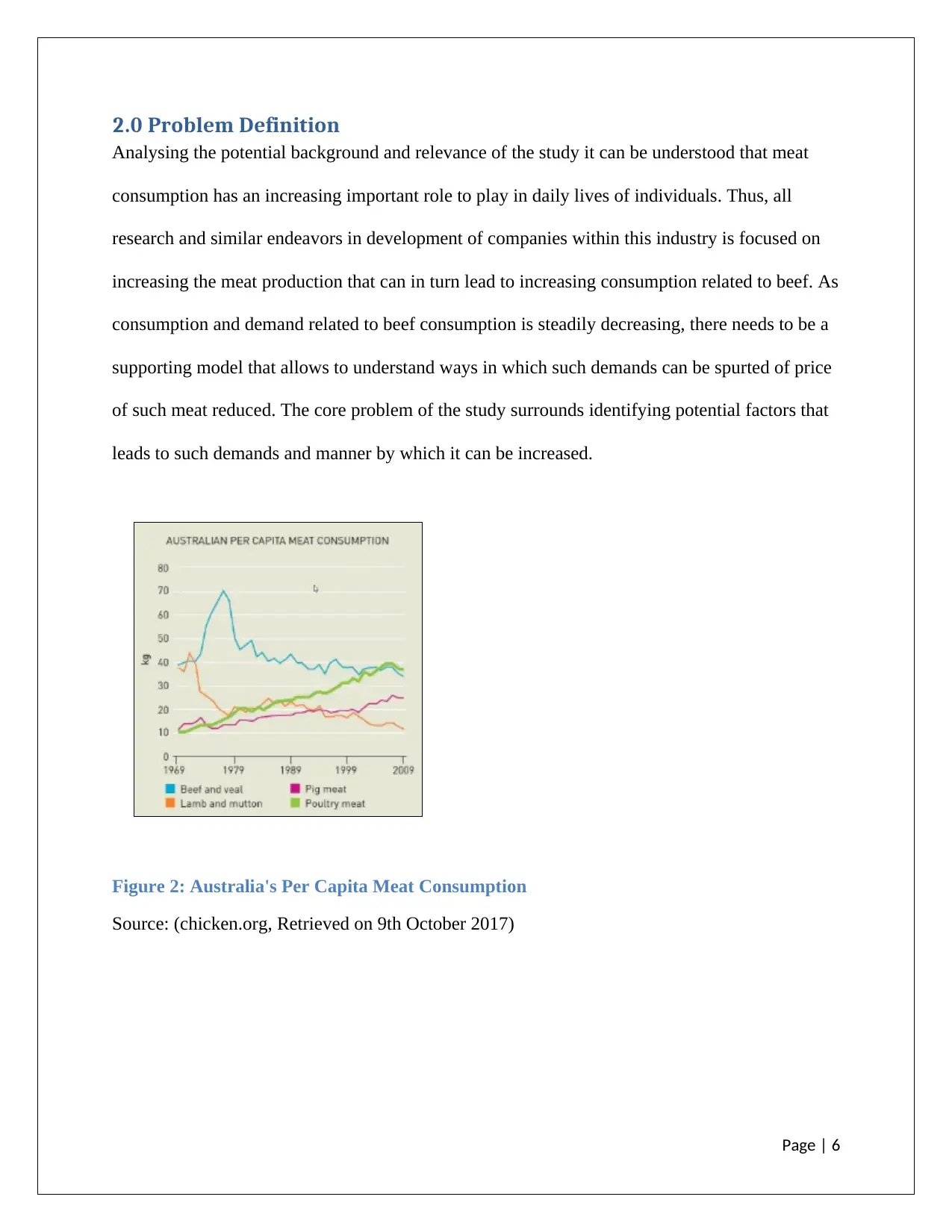
2.0 Problem Definition
Analysing the potential background and relevance of the study it can be understood that meat
consumption has an increasing important role to play in daily lives of individuals. Thus, all
research and similar endeavors in development of companies within this industry is focused on
increasing the meat production that can in turn lead to increasing consumption related to beef. As
consumption and demand related to beef consumption is steadily decreasing, there needs to be a
supporting model that allows to understand ways in which such demands can be spurted of price
of such meat reduced. The core problem of the study surrounds identifying potential factors that
leads to such demands and manner by which it can be increased.
Figure 2: Australia's Per Capita Meat Consumption
Source: (chicken.org, Retrieved on 9th October 2017)
Page | 6
Analysing the potential background and relevance of the study it can be understood that meat
consumption has an increasing important role to play in daily lives of individuals. Thus, all
research and similar endeavors in development of companies within this industry is focused on
increasing the meat production that can in turn lead to increasing consumption related to beef. As
consumption and demand related to beef consumption is steadily decreasing, there needs to be a
supporting model that allows to understand ways in which such demands can be spurted of price
of such meat reduced. The core problem of the study surrounds identifying potential factors that
leads to such demands and manner by which it can be increased.
Figure 2: Australia's Per Capita Meat Consumption
Source: (chicken.org, Retrieved on 9th October 2017)
Page | 6
⊘ This is a preview!⊘
Do you want full access?
Subscribe today to unlock all pages.

Trusted by 1+ million students worldwide
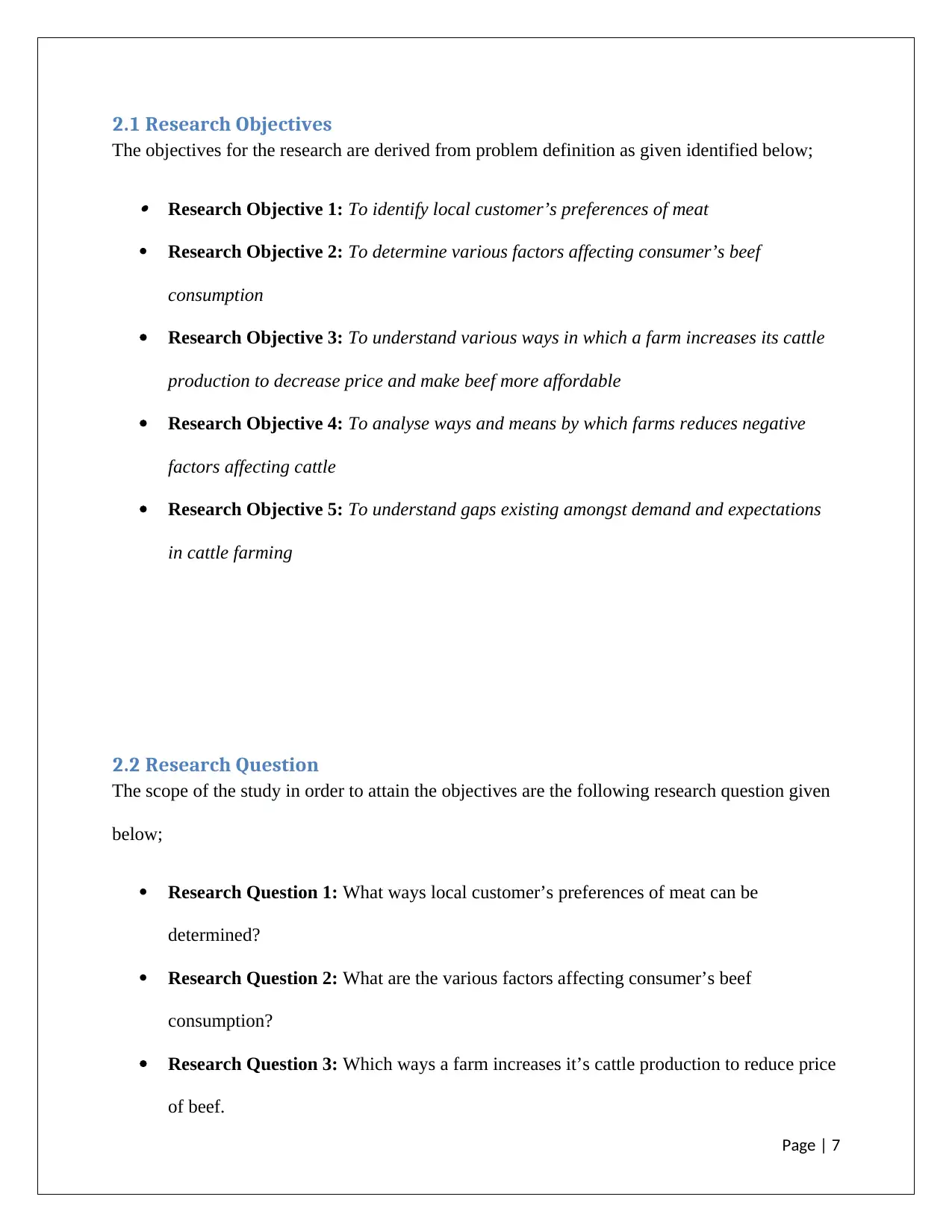
2.1 Research Objectives
The objectives for the research are derived from problem definition as given identified below;
Research Objective 1: To identify local customer’s preferences of meat
Research Objective 2: To determine various factors affecting consumer’s beef
consumption
Research Objective 3: To understand various ways in which a farm increases its cattle
production to decrease price and make beef more affordable
Research Objective 4: To analyse ways and means by which farms reduces negative
factors affecting cattle
Research Objective 5: To understand gaps existing amongst demand and expectations
in cattle farming
2.2 Research Question
The scope of the study in order to attain the objectives are the following research question given
below;
Research Question 1: What ways local customer’s preferences of meat can be
determined?
Research Question 2: What are the various factors affecting consumer’s beef
consumption?
Research Question 3: Which ways a farm increases it’s cattle production to reduce price
of beef.
Page | 7
The objectives for the research are derived from problem definition as given identified below;
Research Objective 1: To identify local customer’s preferences of meat
Research Objective 2: To determine various factors affecting consumer’s beef
consumption
Research Objective 3: To understand various ways in which a farm increases its cattle
production to decrease price and make beef more affordable
Research Objective 4: To analyse ways and means by which farms reduces negative
factors affecting cattle
Research Objective 5: To understand gaps existing amongst demand and expectations
in cattle farming
2.2 Research Question
The scope of the study in order to attain the objectives are the following research question given
below;
Research Question 1: What ways local customer’s preferences of meat can be
determined?
Research Question 2: What are the various factors affecting consumer’s beef
consumption?
Research Question 3: Which ways a farm increases it’s cattle production to reduce price
of beef.
Page | 7
Paraphrase This Document
Need a fresh take? Get an instant paraphrase of this document with our AI Paraphraser
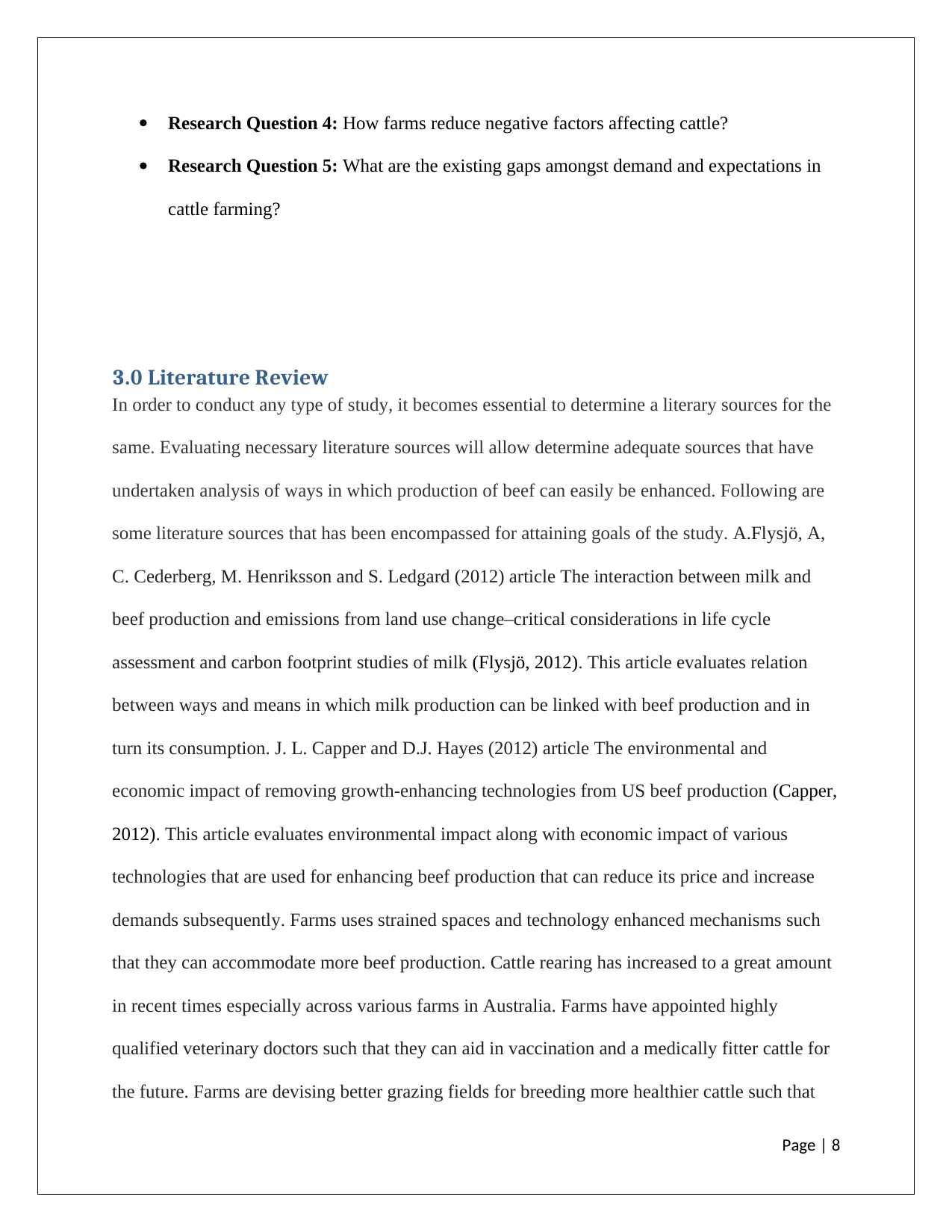
Research Question 4: How farms reduce negative factors affecting cattle?
Research Question 5: What are the existing gaps amongst demand and expectations in
cattle farming?
3.0 Literature Review
In order to conduct any type of study, it becomes essential to determine a literary sources for the
same. Evaluating necessary literature sources will allow determine adequate sources that have
undertaken analysis of ways in which production of beef can easily be enhanced. Following are
some literature sources that has been encompassed for attaining goals of the study. A.Flysjö, A,
C. Cederberg, M. Henriksson and S. Ledgard (2012) article The interaction between milk and
beef production and emissions from land use change–critical considerations in life cycle
assessment and carbon footprint studies of milk (Flysjö, 2012). This article evaluates relation
between ways and means in which milk production can be linked with beef production and in
turn its consumption. J. L. Capper and D.J. Hayes (2012) article The environmental and
economic impact of removing growth-enhancing technologies from US beef production (Capper,
2012). This article evaluates environmental impact along with economic impact of various
technologies that are used for enhancing beef production that can reduce its price and increase
demands subsequently. Farms uses strained spaces and technology enhanced mechanisms such
that they can accommodate more beef production. Cattle rearing has increased to a great amount
in recent times especially across various farms in Australia. Farms have appointed highly
qualified veterinary doctors such that they can aid in vaccination and a medically fitter cattle for
the future. Farms are devising better grazing fields for breeding more healthier cattle such that
Page | 8
Research Question 5: What are the existing gaps amongst demand and expectations in
cattle farming?
3.0 Literature Review
In order to conduct any type of study, it becomes essential to determine a literary sources for the
same. Evaluating necessary literature sources will allow determine adequate sources that have
undertaken analysis of ways in which production of beef can easily be enhanced. Following are
some literature sources that has been encompassed for attaining goals of the study. A.Flysjö, A,
C. Cederberg, M. Henriksson and S. Ledgard (2012) article The interaction between milk and
beef production and emissions from land use change–critical considerations in life cycle
assessment and carbon footprint studies of milk (Flysjö, 2012). This article evaluates relation
between ways and means in which milk production can be linked with beef production and in
turn its consumption. J. L. Capper and D.J. Hayes (2012) article The environmental and
economic impact of removing growth-enhancing technologies from US beef production (Capper,
2012). This article evaluates environmental impact along with economic impact of various
technologies that are used for enhancing beef production that can reduce its price and increase
demands subsequently. Farms uses strained spaces and technology enhanced mechanisms such
that they can accommodate more beef production. Cattle rearing has increased to a great amount
in recent times especially across various farms in Australia. Farms have appointed highly
qualified veterinary doctors such that they can aid in vaccination and a medically fitter cattle for
the future. Farms are devising better grazing fields for breeding more healthier cattle such that
Page | 8
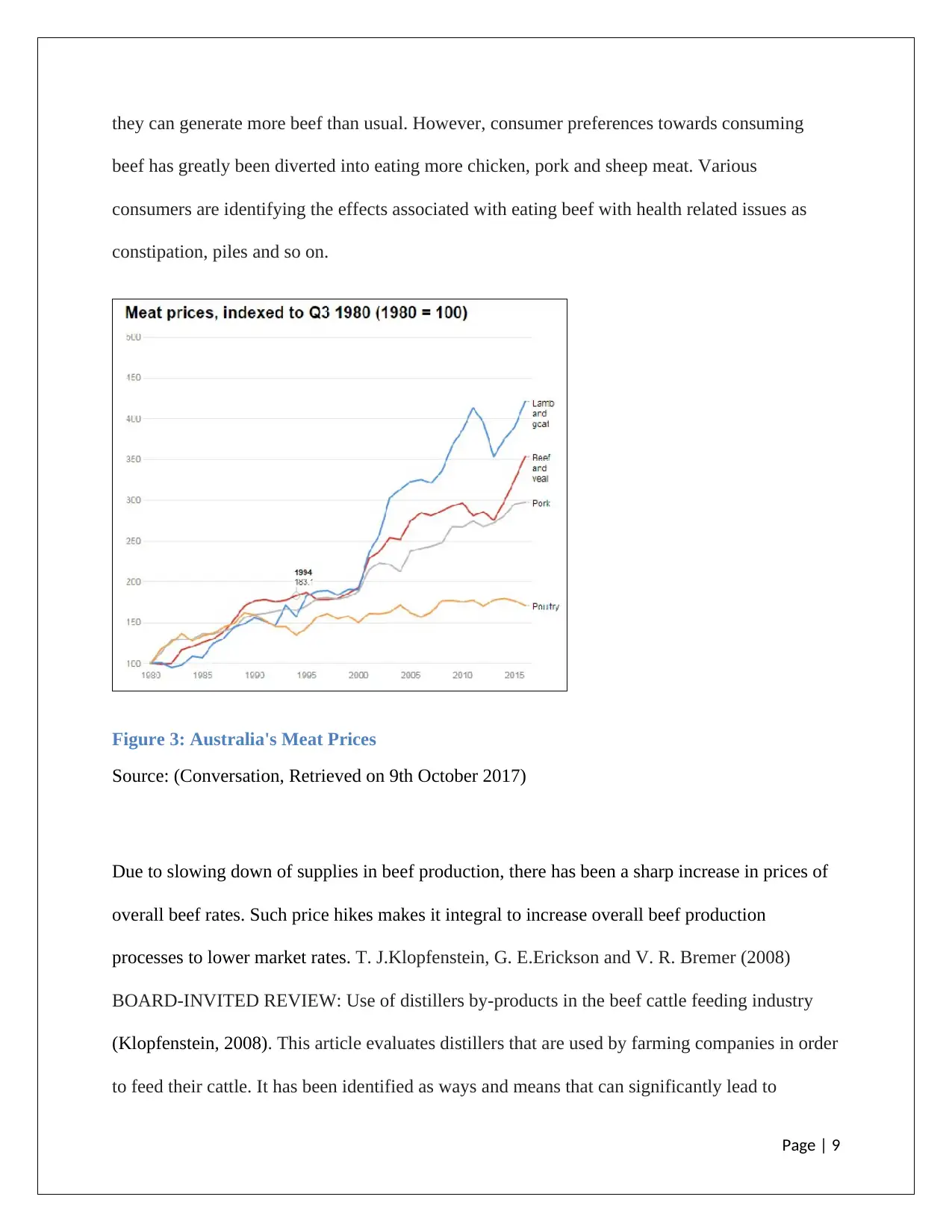
they can generate more beef than usual. However, consumer preferences towards consuming
beef has greatly been diverted into eating more chicken, pork and sheep meat. Various
consumers are identifying the effects associated with eating beef with health related issues as
constipation, piles and so on.
Figure 3: Australia's Meat Prices
Source: (Conversation, Retrieved on 9th October 2017)
Due to slowing down of supplies in beef production, there has been a sharp increase in prices of
overall beef rates. Such price hikes makes it integral to increase overall beef production
processes to lower market rates. T. J.Klopfenstein, G. E.Erickson and V. R. Bremer (2008)
BOARD-INVITED REVIEW: Use of distillers by-products in the beef cattle feeding industry
(Klopfenstein, 2008). This article evaluates distillers that are used by farming companies in order
to feed their cattle. It has been identified as ways and means that can significantly lead to
Page | 9
beef has greatly been diverted into eating more chicken, pork and sheep meat. Various
consumers are identifying the effects associated with eating beef with health related issues as
constipation, piles and so on.
Figure 3: Australia's Meat Prices
Source: (Conversation, Retrieved on 9th October 2017)
Due to slowing down of supplies in beef production, there has been a sharp increase in prices of
overall beef rates. Such price hikes makes it integral to increase overall beef production
processes to lower market rates. T. J.Klopfenstein, G. E.Erickson and V. R. Bremer (2008)
BOARD-INVITED REVIEW: Use of distillers by-products in the beef cattle feeding industry
(Klopfenstein, 2008). This article evaluates distillers that are used by farming companies in order
to feed their cattle. It has been identified as ways and means that can significantly lead to
Page | 9
⊘ This is a preview!⊘
Do you want full access?
Subscribe today to unlock all pages.

Trusted by 1+ million students worldwide
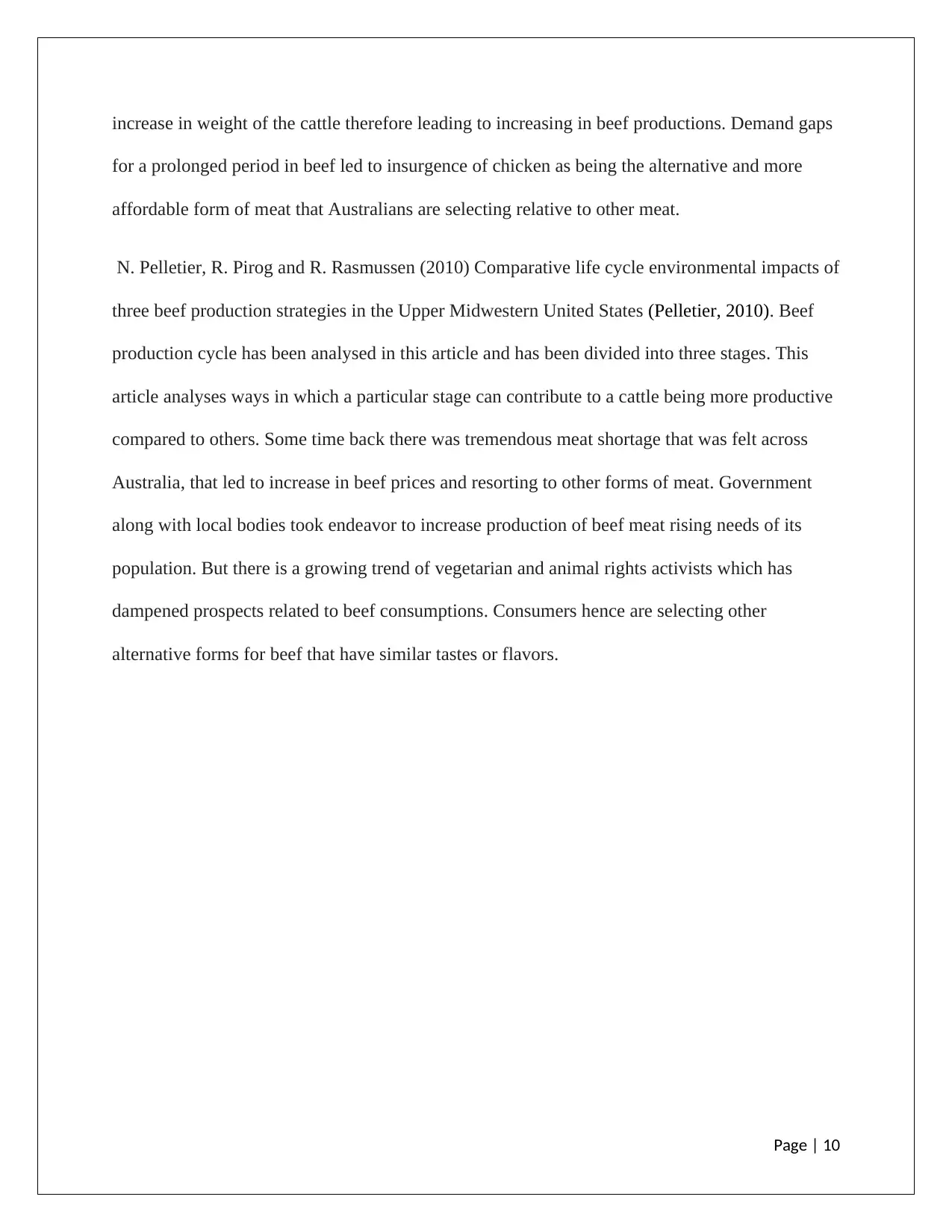
increase in weight of the cattle therefore leading to increasing in beef productions. Demand gaps
for a prolonged period in beef led to insurgence of chicken as being the alternative and more
affordable form of meat that Australians are selecting relative to other meat.
N. Pelletier, R. Pirog and R. Rasmussen (2010) Comparative life cycle environmental impacts of
three beef production strategies in the Upper Midwestern United States (Pelletier, 2010). Beef
production cycle has been analysed in this article and has been divided into three stages. This
article analyses ways in which a particular stage can contribute to a cattle being more productive
compared to others. Some time back there was tremendous meat shortage that was felt across
Australia, that led to increase in beef prices and resorting to other forms of meat. Government
along with local bodies took endeavor to increase production of beef meat rising needs of its
population. But there is a growing trend of vegetarian and animal rights activists which has
dampened prospects related to beef consumptions. Consumers hence are selecting other
alternative forms for beef that have similar tastes or flavors.
Page | 10
for a prolonged period in beef led to insurgence of chicken as being the alternative and more
affordable form of meat that Australians are selecting relative to other meat.
N. Pelletier, R. Pirog and R. Rasmussen (2010) Comparative life cycle environmental impacts of
three beef production strategies in the Upper Midwestern United States (Pelletier, 2010). Beef
production cycle has been analysed in this article and has been divided into three stages. This
article analyses ways in which a particular stage can contribute to a cattle being more productive
compared to others. Some time back there was tremendous meat shortage that was felt across
Australia, that led to increase in beef prices and resorting to other forms of meat. Government
along with local bodies took endeavor to increase production of beef meat rising needs of its
population. But there is a growing trend of vegetarian and animal rights activists which has
dampened prospects related to beef consumptions. Consumers hence are selecting other
alternative forms for beef that have similar tastes or flavors.
Page | 10
Paraphrase This Document
Need a fresh take? Get an instant paraphrase of this document with our AI Paraphraser
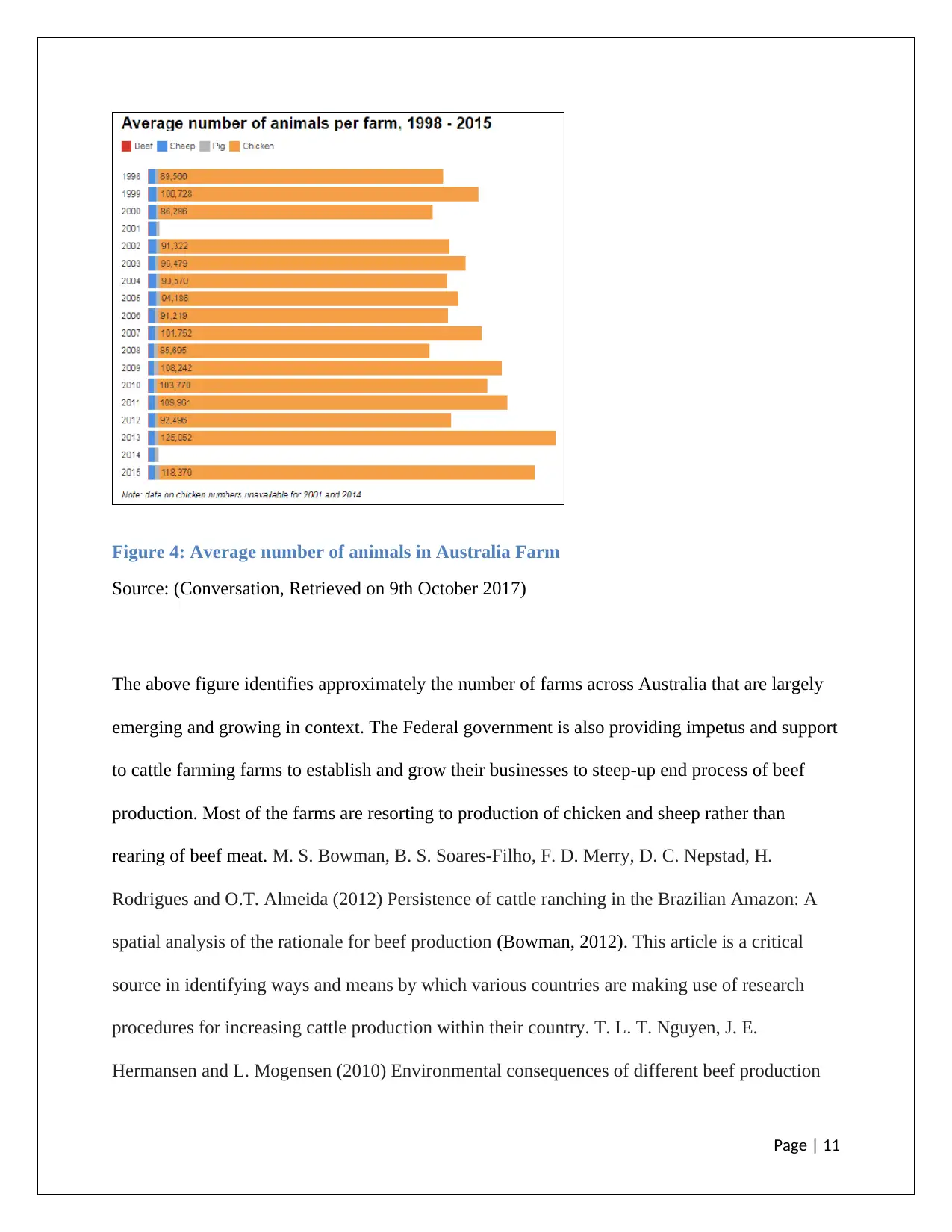
Figure 4: Average number of animals in Australia Farm
Source: (Conversation, Retrieved on 9th October 2017)
The above figure identifies approximately the number of farms across Australia that are largely
emerging and growing in context. The Federal government is also providing impetus and support
to cattle farming farms to establish and grow their businesses to steep-up end process of beef
production. Most of the farms are resorting to production of chicken and sheep rather than
rearing of beef meat. M. S. Bowman, B. S. Soares-Filho, F. D. Merry, D. C. Nepstad, H.
Rodrigues and O.T. Almeida (2012) Persistence of cattle ranching in the Brazilian Amazon: A
spatial analysis of the rationale for beef production (Bowman, 2012). This article is a critical
source in identifying ways and means by which various countries are making use of research
procedures for increasing cattle production within their country. T. L. T. Nguyen, J. E.
Hermansen and L. Mogensen (2010) Environmental consequences of different beef production
Page | 11
Source: (Conversation, Retrieved on 9th October 2017)
The above figure identifies approximately the number of farms across Australia that are largely
emerging and growing in context. The Federal government is also providing impetus and support
to cattle farming farms to establish and grow their businesses to steep-up end process of beef
production. Most of the farms are resorting to production of chicken and sheep rather than
rearing of beef meat. M. S. Bowman, B. S. Soares-Filho, F. D. Merry, D. C. Nepstad, H.
Rodrigues and O.T. Almeida (2012) Persistence of cattle ranching in the Brazilian Amazon: A
spatial analysis of the rationale for beef production (Bowman, 2012). This article is a critical
source in identifying ways and means by which various countries are making use of research
procedures for increasing cattle production within their country. T. L. T. Nguyen, J. E.
Hermansen and L. Mogensen (2010) Environmental consequences of different beef production
Page | 11
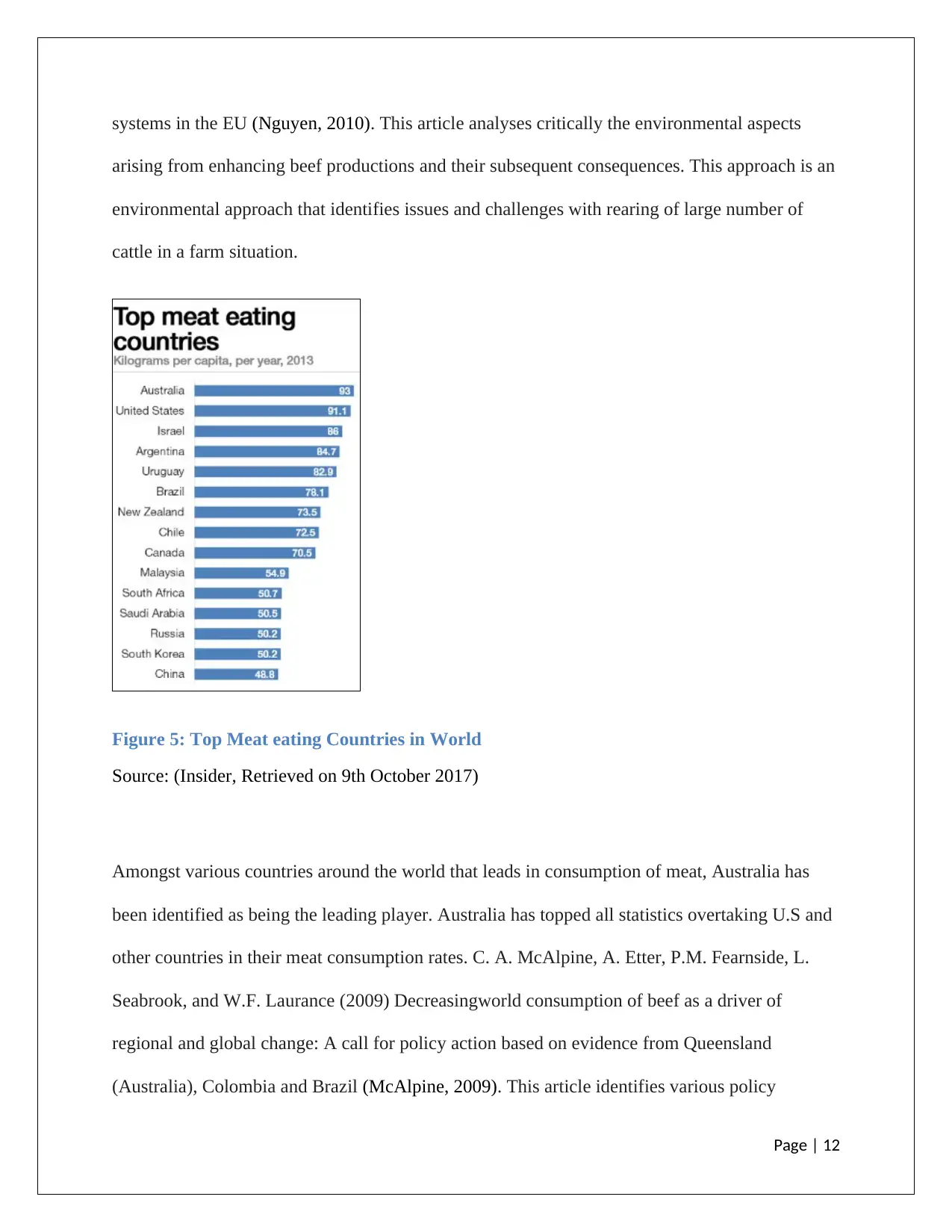
systems in the EU (Nguyen, 2010). This article analyses critically the environmental aspects
arising from enhancing beef productions and their subsequent consequences. This approach is an
environmental approach that identifies issues and challenges with rearing of large number of
cattle in a farm situation.
Figure 5: Top Meat eating Countries in World
Source: (Insider, Retrieved on 9th October 2017)
Amongst various countries around the world that leads in consumption of meat, Australia has
been identified as being the leading player. Australia has topped all statistics overtaking U.S and
other countries in their meat consumption rates. C. A. McAlpine, A. Etter, P.M. Fearnside, L.
Seabrook, and W.F. Laurance (2009) Decreasingworld consumption of beef as a driver of
regional and global change: A call for policy action based on evidence from Queensland
(Australia), Colombia and Brazil (McAlpine, 2009). This article identifies various policy
Page | 12
arising from enhancing beef productions and their subsequent consequences. This approach is an
environmental approach that identifies issues and challenges with rearing of large number of
cattle in a farm situation.
Figure 5: Top Meat eating Countries in World
Source: (Insider, Retrieved on 9th October 2017)
Amongst various countries around the world that leads in consumption of meat, Australia has
been identified as being the leading player. Australia has topped all statistics overtaking U.S and
other countries in their meat consumption rates. C. A. McAlpine, A. Etter, P.M. Fearnside, L.
Seabrook, and W.F. Laurance (2009) Decreasingworld consumption of beef as a driver of
regional and global change: A call for policy action based on evidence from Queensland
(Australia), Colombia and Brazil (McAlpine, 2009). This article identifies various policy
Page | 12
⊘ This is a preview!⊘
Do you want full access?
Subscribe today to unlock all pages.

Trusted by 1+ million students worldwide
1 out of 23
Related Documents
Your All-in-One AI-Powered Toolkit for Academic Success.
+13062052269
info@desklib.com
Available 24*7 on WhatsApp / Email
![[object Object]](/_next/static/media/star-bottom.7253800d.svg)
Unlock your academic potential
Copyright © 2020–2025 A2Z Services. All Rights Reserved. Developed and managed by ZUCOL.





